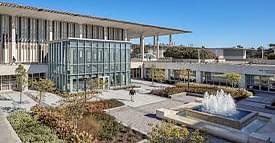Bachelor of Science [B.S] (Marine and Aquatic Biology)
Field of Study:
₹14.7 L/Yr
Marine Laboratory
The department maintains a 3,000-gallon inland marine laboratory with the eight major animal phyla represented in more than 66 genera of marine life including the horseshoe crab, sea anemones, stingray, skates, sea horse, starfish and lobsters.
The lab has been in existence since 1963, when it had five 10-gallon tanks to house animals brought back by students from a spring trip. The lab now has more than 50 tanks cold water tanks, coral tanks, a salt marsh environmental tank, and a touch tank.
The animals in the lab are cared for by students, primarily for class study and research projects, but are also on view for visitors and other students. Marine biology students are encouraged to maintain a tank in the marine laboratory to earn internship credit.
Field Experience
Several courses offer opportunities for field experience in both freshwater and marine scientific techniques. Students can learn basic principles of field research by using scientific instruments including seines, sieves, thermographs, oxygen meters, fluorometers and current meters, and by snorkeling and scuba diving.
Field experience is essential because it allows students to integrate classroom concepts and principles with actual environments and organisms. Hands-on experience prepares students for a future career in freshwater or marine science.
Many marine biology students enroll in field courses offered through the Gulf Coast Research Lab, the Ohio State University’s Stone Lab or one of a number of other marine stations. During these field experiences, students are absorbed in marine ecology studying the different habitats and the organisms found within them. These different habitats include barrier islands, mudflats, salt marsh, rocky shoreline, coral reefs, eel grass beds and continental shore life.
Field experience gives students the chance to learn about becoming a field scientist and allows students to interact with scientists in other laboratories. Students are encouraged to pursue these contacts for possible summer internships.
BGSU students have completed summer internships in diverse locations including Woods Hole Oceanographic Institution, the Marine Biological Laboratory, Shoals Marine Lab, Mote Marine Lab, Sea World, the U.S. Navy Marine Mammal Program, OSU’s Stone Lab and the Gulf Coast Research Laboratory.
Career Opportunities
Understanding the ecology of our lakes and oceans is still a mystery. The study of aquatic habitats can lead to careers in a number of areas. Students may choose to seek employment in such areas as:
- Graduate/academic teaching
- Research aboard scientific vessels
- Mariculture
- Management of natural resources
- Research at coastal laboratories
- Coastal zone management
- National marine fisheries
- Pollution control and toxicology
- Marine technology
- Ocean law and marine affairs
- Pharmaceutical discovery and development
- Work at aquariums or museums
- Research in private industry
TOP Scholarships
| Scholarship name | Award amount | Eligibility |
|---|---|---|
| - | - | - |
| - | - | - |
| - | - | - |
Key Resources for Your Study Abroad Journey
Scholarship Grants & Financial Aids
| Name | Scholarship Per Student | Level of Study | Type | |
|---|---|---|---|---|
| Debesh Kamal Scholarship | Scholarship per student₹ 1.2 L/Yr$1,385 | Level Of StudyBachelor | TypeMerit-Based | |
| Ritchie-Jennings Memorial Scholarship Program | Scholarship per studentVariable Amount | Level Of StudyBachelor | TypeMerit-Based | |
| VueVille Future Technology Scholarship | Scholarship per student₹ 85,940/Yr$1,000 | Level Of StudyBachelor | TypeMerit-Based | |
| Innovation in Education Scholarship - La Tutors 123 | Scholarship per student₹ 42,970/Yr$500 | Level Of StudyBachelor | TypeMerit-Based | |
| RD Sethna Scholarships | Scholarship per student₹ 12.9 L/Yr$15,000 | Level Of StudyBachelor | TypeMerit-Based | |
| Deutschland Stipendium Program | Scholarship per student₹ 3.7 L/Yr$4,363 | Level Of StudyBachelor | TypeCollege-Specific |
Similar Colleges


University at Albany


Northern State University


Abilene Christian University
.jpeg?h=143&mode=stretch)

Ohio Northern University


University of South Carolina


University of Akron


State University of New York Polytechnic Institute


University of New Mexico

























Comments